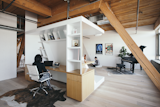Collection by Alexis Vail
Flatiron Penthouse
When violinist Joshua Bell hired Charles Rose Architects to turn the upper floors of an old manufacturing plant in the Flatiron District into his home and salon, he had an unusual request: Make this contemporary penthouse feel like a 300-year-old Gibson Stradivarius violin. And while the central design features of the 4,000-square-foot apartment—like a dramatic oxidized steel-and-glass stair, rooftop atrium, outdoor spa, trellised pergola, and copper-clad chimney—aren’t a strict interpretation of the brief, Rose has replicated the richness and graceful details of the prized wood instrument.
Tribeca Manufacturing Building
New York–based architect Andrew Franz undertook the renovation of a landmark circa-1884 former soap warehouse in Tribeca, originally designed by George W. DaCunha in the Romanesque Revival style. Franz reorganized and modernized the six-story building—which retains its original 16-foot beam ceilings, brick walls, timber columns, and elevator winches from the former freight shaft—by incorporating steel, glass, handmade tile, and lacquer to complement the masonry and heavy timber. An interior courtyard and rectangular mezzanine are situated below the original 16-foot gull-wing ceiling planes.
The lights that cover the ceiling of the open-plan living and dining space were crafted by the Hills out of Ikea floor lamps. "We found these floor lamps that were just a black rod," David says. "We realized we could simply unscrew them off the base, cut the wire, and sleeve them up into the attic." The lamps are designed to expose as much of the metal ceiling tile as possible, which the Hills carefully restored from the original structure. David made the dining table from a plywood sheet, painted black, that sits on top of saw horses.
On the opposite side of the veneer wall, a coat closet helps act as a space divider, while defining the entryway. Frequent collaborators, MWAI describes their relationship with INTERIOR-iD as “more fun than work." The architecture team treated the home’s custom pieces as “building blocks” to help define and partition space, while serving critical and specific functions.
The Virgin chambers break the fusty hotel room mold with a layout that maximizes light and entry space, while placing crucial storage near the entry. Sliding doors can close off the sleeping chamber from the anteroom, which is used as a dressing room with adjacent water closet and shower room. The wardrobes are by Poliform, the flooring is Porcelanosa, and the sink is by Kohler.
The three levels of the house transition from public to private: The ground floor is composed of the kitchen and living-dining area; the bathroom and closet occupy the mezzanine, accessed by a ship’s ladder; and the sleeping loft hovers a couple steps above. The seminal 1970s tome A Pattern Language, written by Christopher Alexander, Sara Ishikawa, and Murray Silverstein, inspired the layout. “I’m a huge proponent of the [book],” says Azevedo. “I like the ideas of a bed as an alcove, natural light on two sides of a room, varying ceiling heights, and different levels of privacy.”
Tasked with transforming a 93-square-foot brick boiler room into a guesthouse, architect and metalworker Christi Azevedo flexed her creative muscle. The architect spent a year and a half designing and fabricating nearly everything in the structure save for the original brick walls. "I treated the interior like a custom piece of furniture," she says.
22 more saves
















![The three levels of the house transition from public to private: The ground floor is composed of the kitchen and living-dining area; the bathroom and closet occupy the mezzanine, accessed by a ship’s ladder; and the sleeping loft hovers a couple steps above. The seminal 1970s tome A Pattern Language, written by Christopher Alexander, Sara Ishikawa, and Murray Silverstein, inspired the layout. “I’m a huge proponent of the [book],” says Azevedo. “I like the ideas of a bed as an alcove, natural light on two sides of a room, varying ceiling heights, and different levels of privacy.”](https://images2.dwell.com/photos/6063391372700811264/6133450457432788992/original.jpg?auto=format&q=35&w=160)


